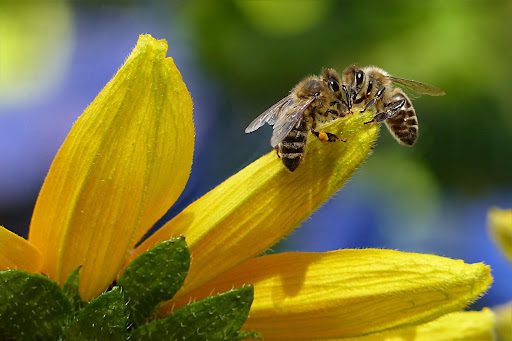Nothing is quite as tranquil as a garden in full bloom. And what better way to enjoy the sights and smells of summer than by sitting back and watching the bees do their work? However, many people are unaware that bees play a vital role in the health of their gardens. By pollinating flowers, bees help to create seedlings and ensure that plants can reproduce. In fact, without bees, many plants would simply cease to exist.
That’s why it’s important to create a pollinator-friendly garden. And luckily, Maine is the perfect place to do just that. With abundant flowering plants and a long growing season, Maine is a bee haven. In this blog post, we’ll share some of the best bee-friendly plants for your garden and some tips on creating a bee-friendly environment.
Benefits Of A Bee-Friendly Landscape
There are many reasons why you should consider making your landscape bee-friendly.
-
Bees Are Important Pollinators
Bees play a vital role in the pollination of plants. They are responsible for the pollination of one-third of the world’s crops. This means that without bees, we would lose a significant amount of our food supply.
-
Bee Gardens Are Low Maintenance
Another great reason to create a bee garden is that they are relatively low maintenance. Once you’ve planted the bee-friendly flowers, there isn’t much else you need to do. Bee gardens don’t require pesticides or other chemicals, making them safer for bees and other wildlife.
-
Bee Gardens Are Beneficial to The Environment
Bee gardens are not only good for bees, but they’re also good for the environment. By planting native flowers and plants, you can help reduce your carbon footprint. Native plants require less water and fewer chemicals to thrive, making them more environmentally friendly.
-
Bee Gardens Create a Habitat For Other Wildlife
In addition to providing a habitat for bees, bee gardens can also provide a home for other wildlife. By planting various bee-friendly flowers, you can attract other pollinators, such as butterflies and hummingbirds. You may even see some new species in your garden that you didn’t have before.
-
Bee Gardens Help Support Honeybees
Honeybees are facing various challenges, including disease, pesticides, and habitat loss. By creating a bee garden, you can help support these important pollinators. By providing them with a safe place to forage and nest, you can give them the boost they need to survive.
Creating A Bee Garden In Maine
Now that you know some of the benefits of creating a bee garden, it’s time to get started. If you live in Maine, there are a few things to take into account before you start planting.
Pick The Right Plants
When creating a bee garden, one of the most important things to consider is the type of flowers you plant. While bees will visit a wide variety of flowers, they are especially drawn to those with large blooms and ample amounts of nectar. In addition, it is important to choose a mix of early-, mid-, and late-blooming varieties to ensure that your garden provides a consistent food source for bees throughout the season.
Some great bee-friendly plants for Maine gardens include:
- Aster
- Blackberry
- Blueberry
- Buttonbush
- Clover
- Echinacea (coneflower)
- Goldenrod
- Lavender
- Milkweed
- Penstemon (beard tongue)
Avoid Harmful Flowers
Not all flowers are bee-friendly. Some flowers can be harmful to bees. Flowers that have been treated with pesticides or other chemicals can be toxic to bees and should be avoided. In addition, many common garden plants, such as impatiens and marigolds, produce very little nectar, making them poor choices for bee gardens. When selecting plants for your bee garden, it is important to choose those that are known to be bee-friendly. By avoiding harmful flowers, you can help keep bees safe and healthy.
Water Is Essential
Bees need water to survive, so it is important to ensure your bee garden has a water source. A bee bath, which is a shallow dish filled with water, is an ideal way to provide bees with the hydration they need. Bee baths should be placed in a sunny spot and kept clean to prevent the spread of disease. In addition, it is important to ensure the bee bath doesn’t dry out. Bees are more likely to visit gardens that have a consistent water source.
Shelter From The Elements
Bees need a safe place to rest and shelter from the elements. By providing bees with a bee box or bee house, you can give them a place to escape the heat, cold, and rain. Bee boxes should be sheltered, either next to a hedge or under a tree. In addition, it is important to ensure that the bee box or bee house is facing south so that it stays warm during the winter months.
Prioritize Native Plants
When creating a bee garden, it is important to choose native plants. Native plants are those that have evolved to grow in a particular area. They are adapted to the local climate and soil and require less water and chemicals to thrive. By planting native flowers, you can provide bees with the food they need while also helping to reduce your carbon footprint. Maine is home to a wide variety of bee-friendly native plants, including black-eyed Susans, Joe Pye weed, and wild blueberries.
Design Tips For Your Bee Garden
When designing your bee garden, it is important to create a space that is both beautiful and functional. Let’s take a look at a few design tips to help you get started.
Use Large Patches Of Flowers
When it comes to bee gardens, more is better. Bees are attracted to large patches of flowers, so be sure to plant plenty of them. This will give the bees plenty of nectar and pollen to gather.
Go Easy On The Pesticides
While you want your bee garden to be beautiful, you also want it to be safe for the bees. Be sure to use pesticides sparingly, if at all. Remember, bees are vital pollinators, and we need them!
Place Nest Blocks For Solitary Bees
In addition to the honey bee, many other bee species are important pollinators. Be sure to provide nesting habitat for these bees by placing nest blocks in your bee garden. Solitary bees will lay their eggs in these nest blocks, and their young will emerge in the spring, ready to pollinate your flowers.
Leave A Few Weeds
Weeds are not usually considered garden-worthy, but they can be quite bee-friendly. Some of the best bee plants are weeds! So, don’t be too quick to pull them up.
Focus Sunlight On Your Flowers
Bees are attracted to flowers that are in full sun. So, if you want to attract bees to your garden, be sure to place your bee-friendly plants in an area that gets plenty of sunlight.
Our Final Thoughts
Creating a pollinator garden is a great way to help pollinators and add beauty to your yard. By following our tips, you can create a bee garden that is sure to please both you and the bees.
Ready to attract pollinators to your garden? Contact the experts at Stone Solutions Maine today to start planning your bee garden!

